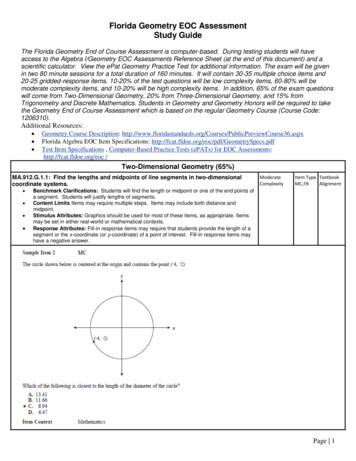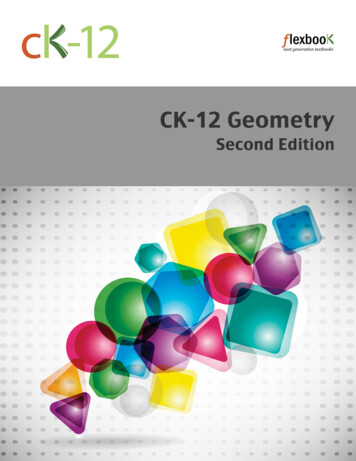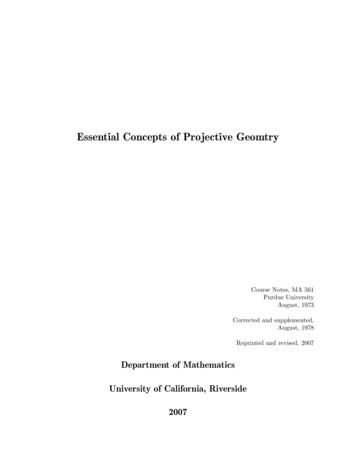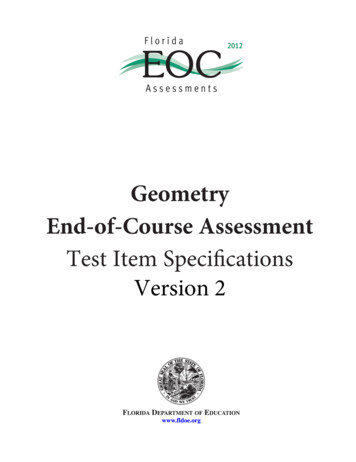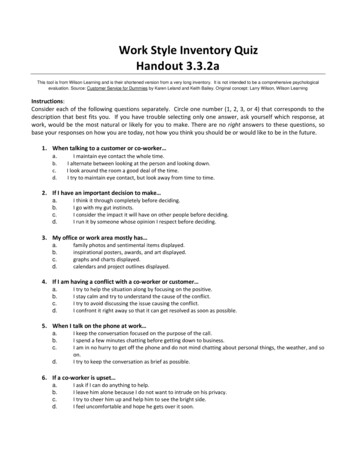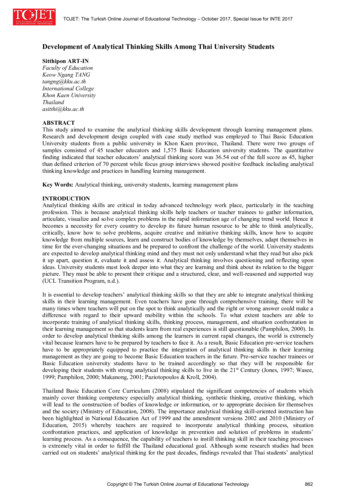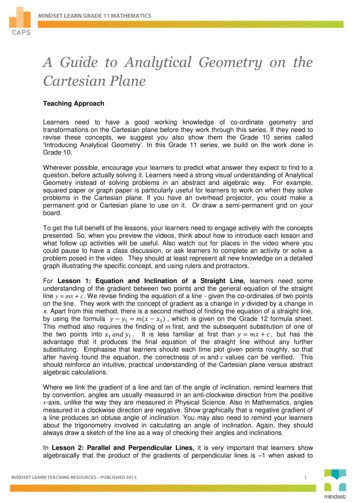
Transcription
A Guide to Analytical Geometry on theCartesian PlaneTeaching ApproachLearners need to have a good working knowledge of co-ordinate geometry andtransformations on the Cartesian plane before they work through this series. If they need torevise these concepts, we suggest you also show them the Grade 10 series called‘Introducing Analytical Geometry’. In this Grade 11 series, we build on the work done inGrade 10.Wherever possible, encourage your learners to predict what answer they expect to find to aquestion, before actually solving it. Learners need a strong visual understanding of AnalyticalGeometry instead of solving problems in an abstract and algebraic way. For example,squared paper or graph paper is particularly useful for learners to work on when they solveproblems in the Cartesian plane. If you have an overhead projector, you could make apermanent grid or Cartesian plane to use on it. Or draw a semi-permanent grid on yourboard.To get the full benefit of the lessons, your learners need to engage actively with the conceptspresented. So, when you preview the videos, think about how to introduce each lesson andwhat follow up activities will be useful. Also watch out for places in the video where youcould pause to have a class discussion, or ask learners to complete an activity or solve aproblem posed in the video. They should at least represent all new knowledge on a detailedgraph illustrating the specific concept, and using rulers and protractors.For Lesson 1: Equation and Inclination of a Straight Line, learners need someunderstanding of the gradient between two points and the general equation of the straightline y mx c. We revise finding the equation of a line - given the co-ordinates of two pointson the line. They work with the concept of gradient as a change in y divided by a change inx. Apart from this method, there is a second method of finding the equation of a straight line,by using the formula, which is given on the Grade 12 formula sheet.This method also requires the finding of first, and the subsequent substitution of one ofthe two points into. It is less familiar at first than, but has theadvantage that it produces the final equation of the straight line without any furthersubstituting. Emphasise that learners should each time plot given points roughly, so thatafter having found the equation, the correctness of and values can be verified. Thisshould reinforce an intuitive, practical understanding of the Cartesian plane versus abstractalgebraic calculations.Where we link the gradient of a line and tan of the angle of inclination, remind learners thatby convention, angles are usually measured in an anti-clockwise direction from the positivex-axis, unlike the way they are measured in Physical Science. Also in Mathematics, anglesmeasured in a clockwise direction are negative. Show graphically that a negative gradient ofa line produces an obtuse angle of inclination. You may also need to remind your learnersabout the trigonometry involved in calculating an angle of inclination. Again, they shouldalways draw a sketch of the line as a way of checking their angles and inclinations.In Lesson 2: Parallel and Perpendicular Lines, it is very important that learners showalgebraically that the product of the gradients of perpendicular lines is –1 when asked to
prove that two lines are perpendicular. Learners should be able to identify the gradient of aline from its equation, and find the negative reciprocals of these gradients, when workingwith perpendicular lines. They will need to practise finding the equations of parallel andperpendicular lines until they are able to do this confidently. It is also important to revise atthis point the drawing of graphs of lines parallel to theor -axes, likeor.When given diagrams with a combination of points and shapes, as in Lesson 3:Quadrilaterals in Analytical Geometry teach learners that questions will always start offwith easy calculations: e.g. the length of a side or the distance/midpoint between two givenpoints. If the perimeter of a triangle is asked, help them visualise that it can be found bywalking around the triangle, i.e. just adding up the lengths of all the sides.Remind learners that there are special kinds of rectangles and parallelograms, like a squareor a rhombus. They need to know the properties of all geometrical figures learnt in theearlier grades, e.g. that the diagonals bisect the angles of a rhombus, which is not the casewith the diagonals of a parallelogram. They obviously have to be reminded of terminologylike ‘bisect’, which means to cut in half. Here it is important also, to quickly revise terms like:an isosceles triangle (which is a triangle where two of the sides are equal), and thedifference between isosceles and equilateral triangles. Have learners copy the appropriatedrawings in their work books themselves. This action per sé, provides instinctivegeometrical understanding, and is convenient for future reference. The quadrilaterals thatare asked in exams most often are the parallelogram, the rhombus and the kite. They arevery logical, practical shapes and if need be, learners could draw them in their workbooks,and easily spot the properties themselves from the respective sketches, and not blindlymemorise abstract facts.Another important tip learners should know about exam questions is that the allocated marksare always a clear indication as to how much working and time is required to solve the givenproblem.
Video SummariesSome videos have a ‘PAUSE’ moment, at which point the teacher or learner can choose topause the video and try to answer the question posed or calculate the answer to the problemunder discussion. Once the video starts again, the answer to the question or the rightanswer to the calculation is given.Mindset suggests a number of ways to use the video lessons. These include: Watch or show a lesson as an introduction to a lesson Watch of show a lesson after a lesson, as a summary or as a way of adding in someinteresting real-life applications or practical aspects Design a worksheet or set of questions about one video lesson. Then ask learners towatch a video related to the lesson and to complete the worksheet or questions, either ingroups or individually Worksheets and questions based on video lessons can be used as short assessments orexercises Ask learners to watch a particular video lesson for homework (in the school library or onthe website, depending on how the material is available) as preparation for the next dayslesson; if desired, learners can be given specific questions to answer in preparation forthe next day’s lesson1. Equation and Inclination of a Straight LineThis video covers equation of a straight line, the gradient and its link to the inclination of aline.2. Parallel and Perpendicular LinesThis video explores the relationship between parallel and perpendicular lines and theirgradients.3. Quadrilaterals in Analytical GeometryThis video covers how to deal with analytical geometry questions involving quadrilateralson the Cartesian Plane.
Resource MaterialResource materials are a list of links available to teachers and learners to enhance their experience ofthe subject matter. They are not necessarily CAPS aligned and need to be used with discretion.1. Equation and Inclination ofa Straight .mathsexcellence.co.za/maths video nes-worksheet-wst5pX.html#close h.com/modules/slopgrph.htm2. Parallel and and-A note on the revision of the lawsof exponents and surdsA series of tutorial videos forGrade 11 and 12 MathsAn online worksheet on straightlinesMaths 911 Live Show RecordingGrade 11 Analytical GeometryMaths 911 Live Show RecordingGrade 11 Analytical GeometryLow level Cartesian plane gameWorkedexamplesandexplanations on how to find theequation of a straight line throughtwo pointsWorked examples and videos onbasic coordinate geometryWorkedexamplesandexplanations on slope and yinterceptExplanations and videos onequations of lines parallel to x andy axesExplanations and videos onfinding equations of parallel andperpendicular linesExplanations on perpendicularlinesWorked examples on how to findthe equations of parallel andperpendicular linesVideo lessons on how to find theequationsofparallelandperpendicular linesKhan Academy videos.
ticgeometry/e/line /geometry/straight-line/3. Simplifying Expressionswith skwirk.com.au/p-c s12 u-83 t-150 watch?v sbira4F62gUhttp://www.youtube.com/watch?v /Explanation on finding equationsof parallel and perpendicular linesSeveral video resources as wellas teach yourself and test yourselflessons on the slope of thestraight lineExplanations on slopes of paralleland perpendicular linesExamplesonfindingtheinclination of a line, as well asexercises and answersExplanation of inclination of a lineVideo clip explaining inclinationangle of straight lineExplanation of angle of inclinationas well as test yourself quizYouTube clip (4:32) on how tofind the angle of inclinationYouTube clip (15 min) on how todetermine the angle of inclinationExplanation of how to find theangle of inclination of a straightline as well as a test yourself withanswersVideo clip on angle of inclinationof a straight line
TaskQuestion 11.11.21.31.41.5Determine the perimeter of. Leave your answers in simplified surd form.Hence, give a reason why.Determine the size of.Ifbisects, determine the gradient of line.Calculate the x-coordinate of point D.Question 2ABCD is a parallelogram.2.1 Determine the coordinates of the midpoints of both AC and BD.2.2 What can you deduce from your answers in 2.1 about the diagonals of a parallelogram?2.3 Calculate the gradients of both AC and BD, and say what the relationship is betweenthese two lines.2.4 Hence, give the name of the type of parallelogram that ABCD is.2.5 Determine the equation of.2.6 Determine the value of , ifis the x-intercept of line.2.7 Determine the magnitude of.2.8 In, determine the equation of the line from C perpendicular to AB.
Task AnswersQuestion 11.1 perimeter 1.2 (Pyth)1.3 1.4(BD bisects) (1.5 Equation of BD: x-intercept: QUESTION 22.12.2 Diagonals of //m bisect each other.2.3 2.4 Rhombus (diagonals bisect perpendicular)2.5
2.6º 2.7 2.8C(2;-2) AcknowledgementsMindset Learn Executive HeadContent Manager Classroom ResourcesContent Coordinator Classroom ResourcesContent AdministratorContent DeveloperContent ReviewerDylan BusaJenny LamontHelen RobertsonAgness MunthaliLidwinia NieuwoudtGhairoeniesa JacobsHelen RobertsonProduced for Mindset Learn by TrafficFacilities ManagerFacilities CoordinatorDirectorEditorPresenterStudio CrewGraphicsBelinda RenneyCezanne ScheepersBelinda RenneyKim NaiduBelinda RenneyKensiwe MathebulaAbram TjaleJacolene VenterCreditsSponsored by Telkom FoundationThis resource is licensed under an Attribution-Share Alike 2.5 South Africa licence. When using thisresource please attribute Mindset as indicated athttp://www.mindset.co.za/creativecommons
A Guide to Analytical Geometry on the Cartesian Plane Teaching Approach Learners need to have a good working knowledge of co-ordinate geometry and transformations on the Cartesian plane before they work through this series. If they need to revise these concepts, we

